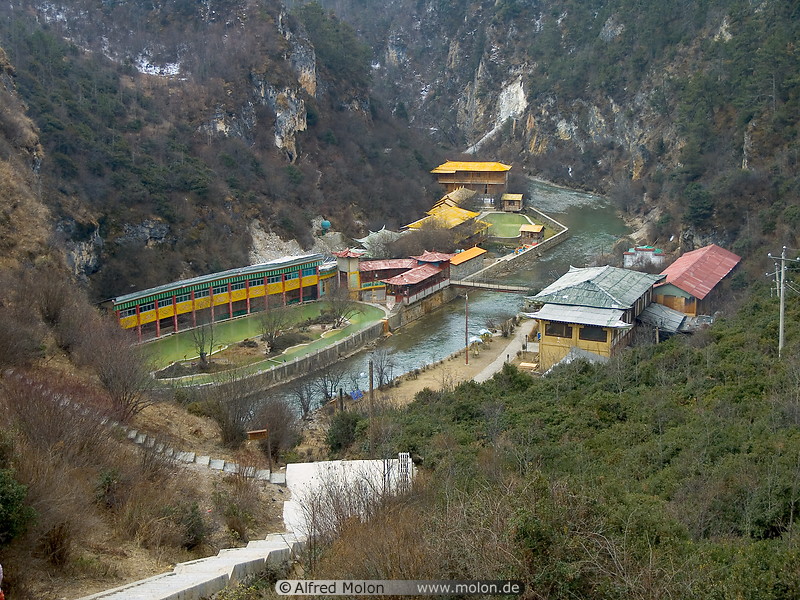In the northern most section of Yunnan province, lies Diqing Autonomous prefecture, where the dominating minority consists of mostly Tibetans and Lisu. Tourists is important here such that the Chinese town (officially the county of) of Zhongdian (Gyalthan to the Tibetans) has been re-named as Shangri La, the mystical nowhere land, which in itself refers to the incorrect use of Shambala by the author of lost Horizon, James Hilton, which is a state of enlightenment rather than a physical place (1).
Grotty
One of the tourist things to do is hike round Meili mountain, located in Zhongdian county. On the way there is the hot spring of Xidang (Xi Dang, Xidan). In contrast to the trek the hot springs are not so photogenetic:
Dmalling is disappointed:
More accessible are two soaking sites not far from Zhongdian itself. The most popular of the two is Tiansheng Qiao (Rangjung Dosam), roughly 10 km south of Zhongdian. Besides the hot spring, the area is known for it's natural bridge formation. Combining these tourist attractions means the need for development. Usually celebrating the natural soaks of the wider western Himal area Daniel Winkler remarks:
 Photo with no description.
Photo with no description.
Taken from above the natural bridge, the hot springs (large circular pool) are on the opposite bank.
Floaties
Only 6 km from Tiansheng Qiao is the hot spring of Xiagei. SeeYunnan.net, the provincial tourism site is one of the few resources on this hot spring:
(1) Arlt, W. G. & X. Honggang Tourism Development and Cultural Interpretation in Ghanzi, China. In: Ryan C, & G. Humin (Eds.) (2009) Tourism in China: Destination, Cultures and Communities. Routledge, New York, U.S.A.
Grotty
One of the tourist things to do is hike round Meili mountain, located in Zhongdian county. On the way there is the hot spring of Xidang (Xi Dang, Xidan). In contrast to the trek the hot springs are not so photogenetic:
'The hot springs themselves could be experienced in a series of small, seriously grotty (to borrow a Rough Guide favorite) shacks'.Funny how this was published on the Not so Lonely Planet site by Andris and Cara!
Dmalling is disappointed:
'The hot springs were sort of like a bathtub -- just a concrete basin with a faucet that tapped into the hot water in the ground. The basins were housed in what looked like a bathroom. Getting your feet wet is really the extent of what you could do here, no swimming in a warm refreshing pool'.One of the best blogs ever (presonal view) retraces Dr Joseph Rock's footsteps, amongst others around Meili mountain. I wonder what the Dr himself would have thought of the hot springs? His disciple describes it as follows:
'These few bathing sheds were run by a Sichuanese guy who seemed extremely bored with his post. It was very cold and damp there, so the warm baths were a welcome chance to get the circulation going - at least temporarily'.Closer to Town
More accessible are two soaking sites not far from Zhongdian itself. The most popular of the two is Tiansheng Qiao (Rangjung Dosam), roughly 10 km south of Zhongdian. Besides the hot spring, the area is known for it's natural bridge formation. Combining these tourist attractions means the need for development. Usually celebrating the natural soaks of the wider western Himal area Daniel Winkler remarks:
'Big hot pool, steam cave, cooling off in the river, awesome setting. These springs, although developed, are great!'
 Photo with no description.
Photo with no description.Taken from above the natural bridge, the hot springs (large circular pool) are on the opposite bank.
Only 6 km from Tiansheng Qiao is the hot spring of Xiagei. SeeYunnan.net, the provincial tourism site is one of the few resources on this hot spring:
'It is located beside a river and below a cave. Private rooms are available but it is nicer to swim in the public pool. Shops sell bathing suits if you are in need of one. This is one of the few completely natural, mostly local Tibetan, clothing optional hot spring areas you will come across'.It's good that this website distinguishes different hot springs. Many web references (such as this one by Rough Guides) refer Xiagei as being Tiansheng Qiao. A Dutch language email by Bart also refers to the separate existence. Roughly translated:
'The Tiansheng Rockbridge is a hole in the mountain where the river runs through. It's great ... together with the other intrigued locals (who have been in the Xiagei hot spring for weeks, even though it's freezing). The women are not that ashamed, they were all in their monokini! The Chinese tourists though preferred to soak in the purpose built swimming pool with their floaties'.Possibly the two are one? This web site describes a distance of 500 m. It's the details which lead me to think both are the same ...:
'This was a private pool and an entrance fee was charged. There was also a public pool located about 500m away where the locals soak in and also open to visitors who are not too concerned about their modesty or the lack of it (topless Tibetan ladies)'.Notes:
(1) Arlt, W. G. & X. Honggang Tourism Development and Cultural Interpretation in Ghanzi, China. In: Ryan C, & G. Humin (Eds.) (2009) Tourism in China: Destination, Cultures and Communities. Routledge, New York, U.S.A.


No comments:
Post a Comment